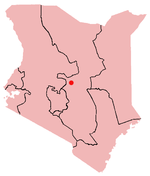
Isiolo is a town in the former
Eastern Province,
Kenya. It is situated in the Upper Eastern sub-region, and lies 285 kilometres north of
Nairobi, the capital city of Kenya. The town grew around the local
military camps, much of the population being descended from former
Somali soldierswho had fought in
World War I as well as other
Cushitic-speaking pastoral communities and the
Ameru community. The town has an estimated population of 80,000 people, most of them living in the rural outbacks of the District. There is an increasing urban population in the recent years, especially from as far as Moyale, Marsabit and Mandera. The Isiolo town is also becoming a centre of interest because of its newly acquired status as a resort city cashing in on the popular Samburu and Shaba Game reserves, which have become preferred destinations after the famed Maasai Mara.
[1] Isiolo lies along the long
A2 Road, leading towards
Marsabit and
Moyalemuch farther north. The town is served by
Isiolo Airport, which is set to be upgraded to an
International Airport to serve tourism and local exports.
[2]
Isiolo is set to become a major part of Kenya's
economic development plan
Vision 2030.
[3] The plan calls for Isiolo to become a tourist center that will include casinos, hotels, upscale retail outlets, a modern airport and transport facilities. Isiolo will also be a transport hub as the location of the fork of the
LAPSSET.
Isiolo District was designated as the Headquarters of the Northern frontier Districts by The British East Africa Protectorate in 1922, until the North Eastern was curved out as a separate province in 1963 following the Lancaster House Constitutional conference.
Isiolo is also known for its large
market, while brass, copper and aluminum
jewelry[4] making is a local industry. Isiolo town is also transport hub to the northern border town of moyale. Trucks to and from Moyale make stop overs boosting the hotel business in the town center. Isiolo town itself was a part of the Nyambene county council and was transferred to isiolo district (this info. is not correct, Isiolo has been the headquarters of N.F.D. far before idepedence ref. District ordinance act 1937 & NFD commission 1962. Isiolo had been an urban centre all along and had never been part of Meru. During colonial days people from Meru District had to have special pass to visit Isiolo, as isiolo was headquarter of NFD, which was a closed district)a closed since there was no urban centre to serve as district headquarters. The
Samburu,
Buffalo Springs and
Shaba National Reserves lie north of the town, while
Lewa Downsreserve is located south of Isiolo. The
Meru National Park lies in the North East of the town.
Since 1995, the town has been the seat of the
Vicariate Apostolic of Isiolo. On July 14, 2005, Bishop
Luigi Locati, who represented the Roman Catholic Church in Isiolo, was murdered. The High Court sent Father Guyo Waqo Malley and four others — Mohamed Molu, Aden Ibrahim Mohammed, Mahati Ali Halake and Roba Balla Bariche — to the gallows for planning and murdering Bishop Luigi Locati.
The town of Isiolo is small but cosmopolitan. With a scenic beauty of hills surrounding the down and including an eclectic mix of peoples and cultures, Isiolo is home to the
Niger–Congo and
Nilo-Saharan-speaking
Ameru,
Samburuand
Turkana, as well as the
Cushitic-speaking
Rendille, Somali and
Boranpeople. The
Somali residents, who first settled in the area as soldiers after
World War I, are mostly business people who engage in livestock farming. Additionally, there are some Indian shopkeepers.
The town is majorly Muslim populated and has a several mosques. The Jamia mosque is the largest of all and also a remarkable landmark. The Catholic church's twin bell towers are also among the remarkable landmarks of Isiolo town. Generally the town has warm climate and has several trees within the town to provide shades. During June–August period the town experiences strong dry winds and generally very dusty.
[5]
Daisy Waugh's book
A Small Town in Africa (1994) is about six months Waugh spent living in Isiolo.
American actor
Drew Barrymore opened The Barrymore Learning Academy, a school in Isiolo, in 2004.
[6]
















